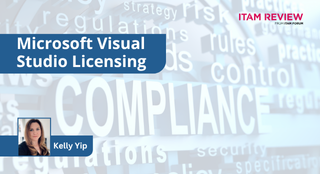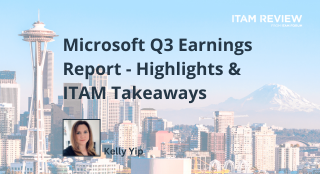Understanding your IBM Contract - Six Key Points

Katerina Motlova
(On 6 June 2025, we checked this article for accuracy and updating.)
This article was contributed by Katerina Motlova of Fisher ITS.
Like many major software publishers, IBM contracts can be long and complex. This is usually true for larger customers who will hold an Enterprise Software & Servicing Offering (ESSO) agreement, rather than a standard Passport Advantage contract that other IBM users will be issued with.
If you do not read and understand your IBM contract, you cannot hope to take advantage of it. It’s often the case that a contract will be signed by Procurement or even the CIO, and the SAM team will not receive important information such as reporting requirements or advantageous commercial terms that allow for future investments to be paid for out of pre-allocated pots of money.
Contract terms vary from vendor to vendor. IBM customers should not assume that because they’re familiar with say Microsoft, you understand IBM licensing terms and definitions.
To take full advantage of your IBM contract, here are six points.
IBM Contract Amendments
When a customer’s contract needs to be updated, IBM will add an amendment, rather than voiding the current contract and starting again. The amendment will contain the information you need to understand for any changes made to the body of the contract.
Some amendments are more important than others. In some cases, an amendment will be updating a small change to the conditions of the contract. In other cases, the amendment will be voiding and updating half of the body of the contract. This is an area where IBM customers can often be caught out. You must consider the body of your contract together with the amendments.
It’s important to distinguish between amendments that extend the contract and amendments that change the conditions of a contract. When a contract is extended, IBM will usually add an amendment to confirm the extension, unless the customer insists on a brand-new contract agreement. Other amendments will not change the fundamental conditions of the contract. They may be there to add additional functionality or a new purchase into the contract.
IBM Contract Definitions
IBM includes a section in each contract to define the terms used throughout the document. Yes, this is the boring bit of the contract This is helpful and better than some other vendors (such as Oracle) that don’t usually provide a clear explanation for the technical language within the contract.
It’s important to remember there may be differences between a generally accepted SAM definition of a term and the IBM definition. IBM also has slightly different definitions for some terms compared to other vendors. Sometimes, we see IBM customers fall into a false sense of security by believing they understand the IBM contractual language based on a familiarity with other vendors. It’s best not to assume you know what IBM terms such as ‘capacity, resource or authorised usage’ mean. Refer to the contract definitions so that you’re sure.
Substitutions Pots
Substitution Pots and Cross-Brand Allotment (see below) are usually the two biggest instruments we see in an IBM contract. When an organisation aims to reduce spend with IBM due to changes in the business or a reduced need for licences, IBM may offer the use of a list of ‘Substitutable Programmes.’ This is also commonly referred to as ‘Substitution Pot’.
IBM will keep the money to the value of the current contract (or as close to the original value as possible) but offer the difference as a form of credit. This allows the customer to purchase certain licences from this ‘pot’ of money.
Substitution Pots are used for IBM customers with an ESSO agreement that includes a set list of licences. When some of these licences are no longer used, they can be swapped out with the items listed on the Substitution schedule. Bear in mind, once swapped, you’ll lose the original licence.
Substitutable Programmes are listed in an organisation’s ESSO agreement. IBM customer cannot use Substitution Pot money for any other purchases. Normally, once a licence is procured via substitution, it becomes part of the customer’s portfolio and cannot be ‘returned’ via another substitution. Substitutable Programmes can be a useful tool to use for new licence ‘purchases’ e.g. for testing purposes or future expansion of your IBM estate.
IBM customers should consider their Substitution Pot before buying new licences. Check whether there is anything no longer needed that can be swapped out first, before paying cash. This may sound basic and obvious. However, time and time again we see organisations that don’t realise they have a Substitution Pot. Or, the one person who knows is not involved in IBM procurement decisions. Money in Substitution Pots is easily wasted unless carefully managed. A centralised process for decision making on new licences is vital for all large contracts.
Cross-Brand Allotment
This is effectively a pre-paid credit pot. You can use this pot of money to buy any IBM software, sometimes even hardware and services. Cross-Brand Allotment is similar to Substitutable Programmes but often better for a customer. It will contain fewer limitations on how the money can be used. Unless listed otherwise, a customer can choose products from the full IBM catalogue. Usually, Cross-Brand Allotment can be used to pay for mainframe purchases or services as well.
Customers should ensure they read and understood the conditions for using Cross-Brand Allotment. Cross-Brand Allotment is typically made available in stages. You might not have access to the full amount right at the beginning of your ESSO. If you do not utilise the Cross-Brand Allotment money available during the allocated time period, YOU WILL LOSE IT.
Audit Clause
IBM don’t use the word ‘audit’ in their contractual language. Instead, they refer to the audit process as ‘verification.’ It’s important to read and understand this clause as it may differ in an ESSO agreement compared to the standard language used in a Passport Advantage contract. Whatever the wording, every contract will have an audit clause.
The standard Passport Advantage audit clause is very simple, stating that IBM can audit the customer and the customer is responsible for providing data within a reasonable timeframe. However, the verification language in an ESSO agreement may be a bit more complicated and have additional terms. This can include a ‘non-audit timeframe’ or other reporting responsibilities. The verification clause in a customer contract will supersede any other clauses referring to auditing elsewhere.
Product List
An IBM contract will usually include a list of products the customer is purchasing through the contract. This will be a table at the end of the contract listing the quantities of each product purchased. It will also include a list of products for which the customer is extending support through that contract. The support may be extended for the entire length of the contract or just one or two years depending on what the customer has agreed. That is important to check, alongside Passport Advantage, to obtain a complete record of your IBM licensing entitlement.
In some cases, a customer may not have access to all the Passport Advantage sites for their organisation. Using the information in the contract is a good way to understand if there are licences not showing within the Passport Advantage sites that the customer has access to. This can help you discover if you are missing access to an important site.
This article was contributed by Katerina Motlova of Fisher ITS.
Can’t find what you’re looking for?
More from ITAM News & Analysis
-
Broadcom vs Siemens AG - A Brewing Storm
The ongoing legal battle between VMware (under Broadcom ownership) and Siemens is yet another example of why ITAM goes far beyond license compliance and SAM. What might, at first glance, appear to be a licensing dispute, ... -
Shifting Left Together: Embedding ITAM into FinOps Culture
During one of the keynotes at the FinOps X conference in San Diego, JR Storment, Executive Director of the FinOps Foundation, interviewed a senior executive from Salesforce. They discussed the idea of combining the roles of ... -
Addressing the SaaS Data Gap in FinOps FOCUS 2.1
I recently reported on the FinOps Foundation’s inclusion of SaaS and Datacenter in its expanded Cloud+ scope. At that time, I highlighted concerns about getting the myriad SaaS companies to supply FOCUS-compliant billing data. A couple ...
Podcast
ITAM training
Similar Posts
-
Microsoft Visual Studio Licensing Guide: Reduce Risks
(This article was reviewed and updated on 3 July 2025) Visual Studio Licensing Visual Studio subscriptions are licensed Per User with each licensed user able to. “install and use the software on any number of device”. ... -
Broadcom vs Siemens AG - A Brewing Storm
The ongoing legal battle between VMware (under Broadcom ownership) and Siemens is yet another example of why ITAM goes far beyond license compliance and SAM. What might, at first glance, appear to be a licensing dispute, ... -
Microsoft Power Apps: Current Pricing Models Comparison
Back in November 2021, Microsoft made Power Apps available under the pay-as-you-go (PAYG) model, alongside the traditional Per User/Per App options. This PAYG model has gained popularity. It ensures simple rightsizing for Power Apps environments. Here, ... -
Microsoft Q3 Soars as AI and Azure Growth Fuels Market Gains
On the 30th April, Microsoft released its Q3 quarterly earnings report, exceeding expectations and igniting investor optimism. Investors had been keeping a watchful eye on Azure’s Cloud performance after Microsoft’s Q2 Cloud results fell short of ...




